May 31, 2016
Sustainable Fishery Catches Only 30% of Fish Entering Net -- Etchu-type Set Net Fishing in Himi
Keywords: Ecosystems / Biodiversity Food Newsletter
JFS Newsletter No.165 (May 2016)
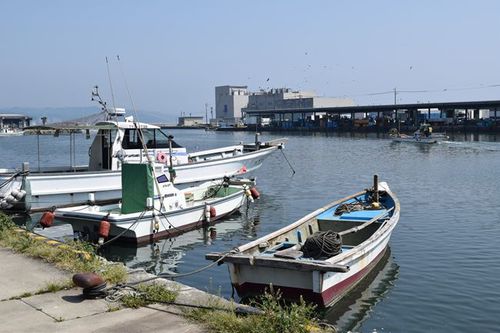
Photo by Juratone Some Rights Reserved.
Japanese and Fisheries
The depletion of fishery resources and collapse of fishing grounds have become a global concern. The people of Japan, an island country surrounded by sea, have traditionally enjoyed fishery products and sea vegetables in their daily diet, and it is said that more than 300 kinds of fish are distributed here for human consumption. For the Japanese, fishery products are extremely important from the viewpoint of not only nutrition but also culture and lifestyle.
Japan's intake of marine products is ranked among the highest in the world. In Japan, fishery products supply about 40 percent of the people's animal protein intake and are essential to the excellent, nutritionally well-balanced Japanese diet. How much seafood do the Japanese eat annually? According to Japan's White Paper on Fisheries in FY2014, the annual per-capita consumption of fish and fishery products peaked in FY2001, at 40.2 kilograms per person. Since then, it has been decreasing, reaching 27.0 kilograms per capita in FY2013. http://www.jfa.maff.go.jp/j/kikaku/wpaper/pdf/hakusyo2014e.pdf
In Japan, the supply of fishery products for domestic consumption (original fish weight equivalent) was about 7.85 million tons in FY2013. Among that, those for human consumption accounted for 79 percent (6.22 million tons), while those for non-human consumption (feed and fertilizer) accounted for 21 percent (1.63 million tons). In that year, the Japanese self-sufficiency ratio in fishery products for human consumption was 60 percent. For the Japanese, who eat plenty of seafood, how to operate a sustainable fishery is a highly crucial issue. This article introduces a sustainable fishery method with a 400-year history, Etchu-type set net fishing in Himi, Toyama Prefecture.
What Is Set Net Fishing?
Of the various kinds of fishing methods, there are two that use fishing nets. One involves use of fishing vessels to chase shoals of fish, such as round haul net and trawl fisheries. The other uses fixed nets in certain places to catch the fish that enter the nets. In the Japanese Fisheries Act, the latter is called "set net fishing." Those set in waters at depths exceeding 27 meters are called "large-scale set net fishing." Currently, some nets are set at depths greater than 100 meters, an achievement enabled by improved fishing gear.
Set net fishing has a long history. In Japan, it is said to have originated from the end of the Muromachi Era (1336-1573) with its form basically established by the end of the Edo Era (1603-1868). According to another account, one set net variety, triangular set nets, is recorded to have come into use around 1615 at the beginning of the Edo Era in Yamaguchi Prefecture.
Etchu-type Set Net Fishery -- Traditional Fishing Method Originating in Himi
The city of Himi lies west of Toyama Bay, facing the bay. It has a population of about 50,000, and has long prospered from its fishing industry. As seven big rivers flow into it, Toyama Bay has much plankton providing food for fish. It is the perfect environment for a fishing ground and is known as a natural fish preserve. The area offshore from Himi has the most well-formed continental shelf in Toyama Bay and is inhabited by many fish, so the fishing industry has flourished there for a long time. I interviewed Yasuhiro Oishi, who grew up in a fishing village well-known for its set net fishery. He heads Himi's Fishery and Fishing Culture Promotion Section in the Town Development Promotion Department.
Set nets can take many different forms depending on the local fishing methods and catch types. The Etchu type uses a triangular set net (dead end net), which originated from the Tensho Period (1573-1592). The diagram below shows the structure of a triangular set net, which attained its current form after many improvements. It consists of four types of nets: guide, main body, slope and first drop.
- Guide net: leads fish into the enclosing net
- Main body net: provides a gathering site for fish to enter initially and wander through. Also called the "playground."
- Slope net: prevents fish once led into the first drop net from escaping it easily
- First drop net: holds fish for recovery.
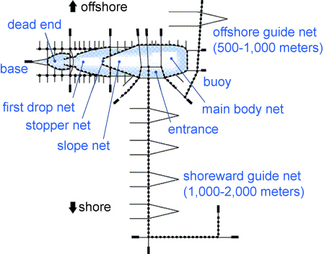

(click to view large image)
Copyright Himi City All Rights Reserved.
In set net fishing, fishermen wait for fish to gather around the set net, unlike round haul net or trawl fishing in which fish are chased. Since fish can enter and exit from the net, only about 20-30 percent of fish that enter the net are caught ultimately. It is an environmentally-friendly fishing practice, avoiding exploitation.
Offshore from Himi, about 40 large and small fixed nets are situated about 2-4 kilometers from the shore at 20-100 meters depth. The large net is over 80 meters wide and 400 meters long for the first drop. The net is 800-900 meters long in total and the guide to lead fish in can be as huge as over 1,000 meters long.
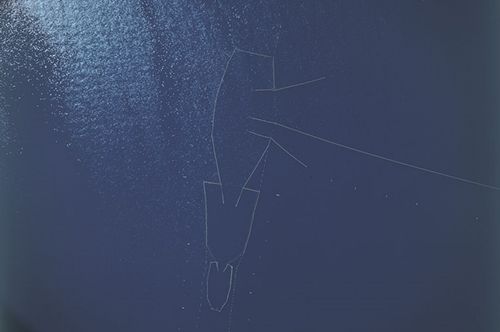
Copyright Himi City All Rights Reserved.
Every morning, it takes about 20-30 minutes for the fishermen to reach the fishing ground and about an hour to bring up the net to recover the fish in the first drop. The fish swimming calmly in the net at that time are bid on for distribution to the market. It takes less than two hours to convey them to market after landing because of the close proximity between the fishing ground and the market. That is one reason the fish of Himi are so fresh and delicious.
When the first drop is lifted, some fishermen make noise and send signals to the fish so that the ones that catch the hint can escape. According to one fisherman, fish smaller than the mesh can freely enter and exit the net, so sometimes small fish can protect themselves by entering the net deliberately when big fish come. This fishing method is gathering attention from the viewpoint of resource conservation because the fish catch can be controlled by the size of mesh.
Oishi says, "Currently the nets are made of nylon, but they were initially straw, then cotton. Both are natural materials which wear out in seawater. Persimmon tannin was used for that reason to coat the nets and increase their durability. It degraded after a while, however. Then the nets were cut free and allowed to sink into the sea. In sea water, they biodegraded and transformed into organic sea grass beds nurturing small fish or providing feeding grounds for fish." The trees on mountains in the coastal area are also protected as "fish breeding forests." This really shows how the ocean, human settlements and mountains are closely linked in material circulation.
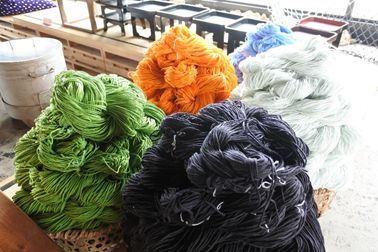
The Etchu-type set net fishing of Himi is highly acclaimed as a sustainable fishery and is spreading throughout the world. After the International Set Net Fishing Summit in Himi in 2002, technical guidance on Etchu-type set net fishing was provided to Thailand through international cooperation in 2005. Then Himi City and the Hokuriku Branch Office of the Japan International Cooperation Agency (JICA) jointly conducted a grass-roots technical cooperation project for Thailand's sustainable coastal fisheries management for three years from 2005. As part of JICA's projects, technology transference to Chile, Trinidad and Tobago, Palau and Tanzania in addition to Thailand has been accomplished.
Himi's Fishery of the Future
Himi's fishery is well known nationally. When people speak about Himi, they immediately think of yellowtail caught in winter, known as kamburi in Japanese. Not just yellowtail, either. In spring, sardines called Himi iwashi (Himi sardines) are caught, with over 120 tons of sardines landed the day I visited Himi Port. In summer, tuna are caught, making the port of Himi vibrant year round. About 80 percent of the fish are caught by set net fishing.
"It is a friendly way of fishing, allowing about 70 percent of fish caught in the net to go out again," I told Oishi. "To be honest, fishermen may want to catch them all," he laughed, "But even for a baseball player, a batting average of 30 percent is enough to be called a great player, so 30 percent of a fish catch can be enough. The fishermen can go fishing tomorrow and the day after tomorrow, too."
Oishi says, "Set net fishing is friendly not only to the environment but also to the people." Fishermen working in deep-sea fisheries leave home for days or even months in some cases. In set net fishing, though, it takes 20 minutes in the morning for the fishermen to "go to work," and they come home in the early evening, which gives them time with their family every day. "Recently, the local fish market closes on Wednesdays and Sundays, so the fishermen work on a five-day week basis. In addition, their income has become stable--they work on a salary rather than commission system influenced by catch volume." Today, more and more aspiring fishermen want to succeed to the Etchu-type set net fisheries, so the local fisheries cooperative is striving to cultivate young fishermen as part of their overall organizational efforts," he says.
I heard that most local people in Himi eat local fish. "Recently, however, most people buy their groceries at supermarkets in Japan. I often go to a local supermarket in Atami, another coastal fishing town, in Shizuoka Prefecture. I find the fish sold there are brought in from many places around Japan, and it is hard for me to find local fish," I told Oishi, to which he replied, "Local fish merchants have branch stores at the supermarkets, too, so people can buy many local fish there." It is good, I think, to have a local fish shop. How nice if there's one at the supermarket!
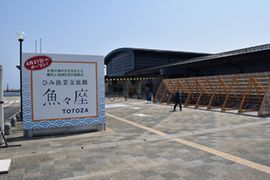

Photo by Juratone Some Rights Reserved.
In April 2015, the Himi Fishery Network Gallery "Totoza" opened as a venue for passing along the fishery culture of Himi to future generations and "weaving bonds" through human communication. It also serves as a new hub for tourism and exchange. I visited the gallery and found an Etchu-type set net system hanging from the ceiling in a wide, open space. I imagined myself a fish under the sea when I looked up at the net above.
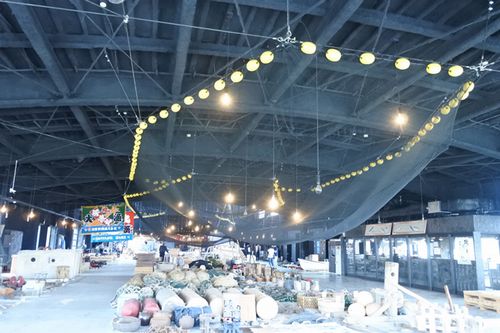
In the future, sustainable fisheries will gain more and more attention. I hope the Etchu-type set net fishing with a 400-year history originating in Himi, will prove more and more useful to the world, and that rich fishing grounds that support fisheries systems will be protected forever.
Written by Junko Edahiro
Related
"JFS Newsletter"
- 'Good Companies in Japan' (Article No.4): 'Eightfold Satisfaction' Management for Everyone's Happiness
- "Nai-Mono-Wa-Nai": Ama Town's Concept of Sufficiency and Message to the World
- 'Yumekaze' Wind Turbine Project Connects Metro Consumers and Regional Producers: Seikatsu Club Consumers' Co-operative
- Shaping Japan's Energy toward 2050 Participating in the Round Table for Studying Energy Situations
- 'Good Companies in Japan' (Article No.3): Seeking Ways to Develop Societal Contribution along with Core Businesses


